- Home
- slideshows
- miscellaneous
- For less than $100, you can tour the abandoned towns around Chernobyl. Just watch out for radioactive trees and dogs, crumbling buildings, and the occasional selfie stick.
For less than $100, you can tour the abandoned towns around Chernobyl. Just watch out for radioactive trees and dogs, crumbling buildings, and the occasional selfie stick.
On April 26, 1986, an explosion at the Chernobyl Nuclear Power Plant, in what was then the Soviet Union, resulted in a cloud of radioactive particles spreading across parts of Europe.

The disaster has gone down in history as the world's worst nuclear accident.
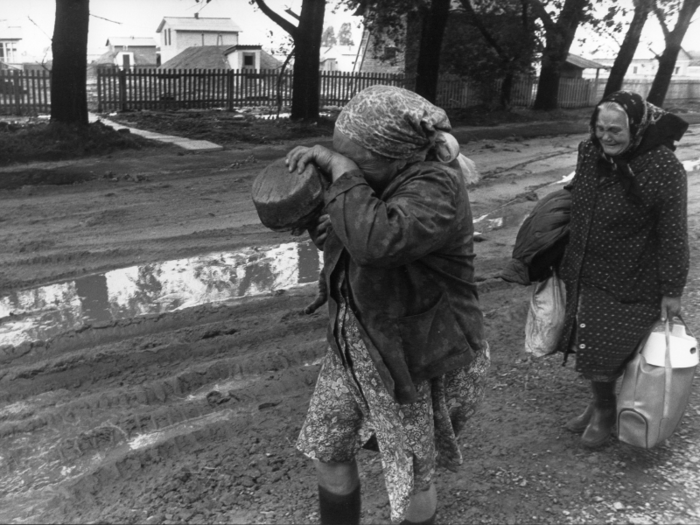
Thirty-one people died in the explosion, and the areas surrounding the plant were permanently contaminated. They're now considered to be some of the most polluted areas on the planet.
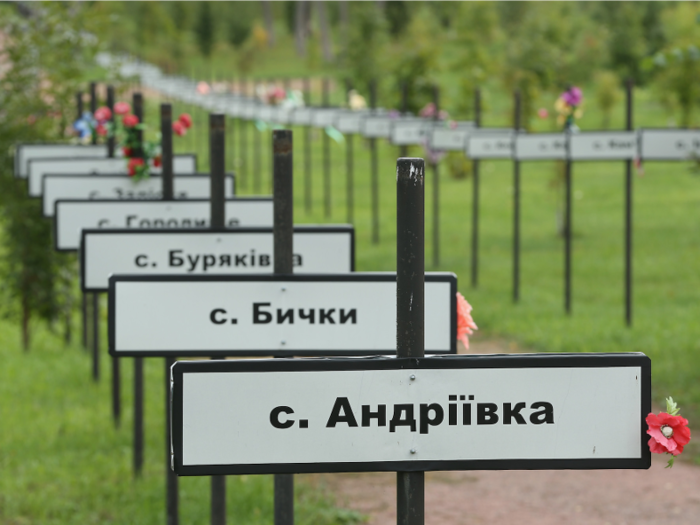
Source: Reuters
As a result of the Chernobyl disaster, an exclusion zone was established in 1986 within a 19-mile radius of the power plant, and access to the area was heavily restricted for almost 30 years.
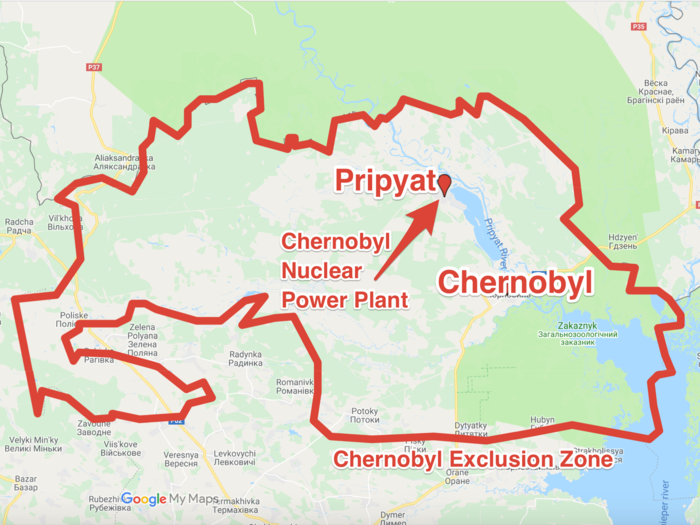
Source: Business Insider
Only a few locals still live within that area ...
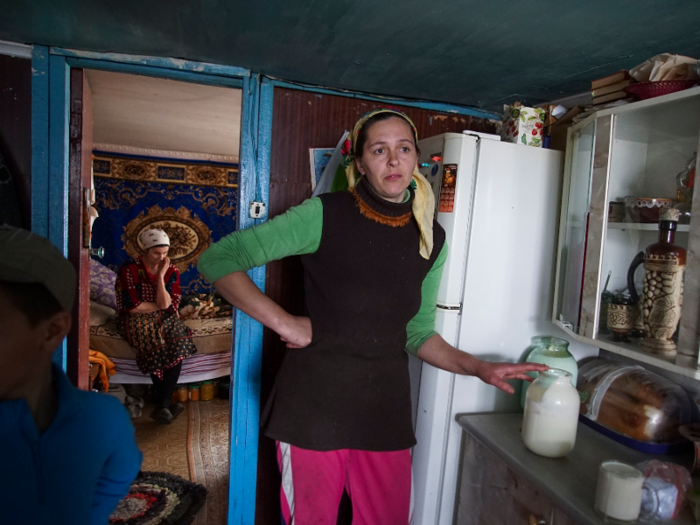
... and there’s a brimming population of wildlife, thanks to the lack of humans.
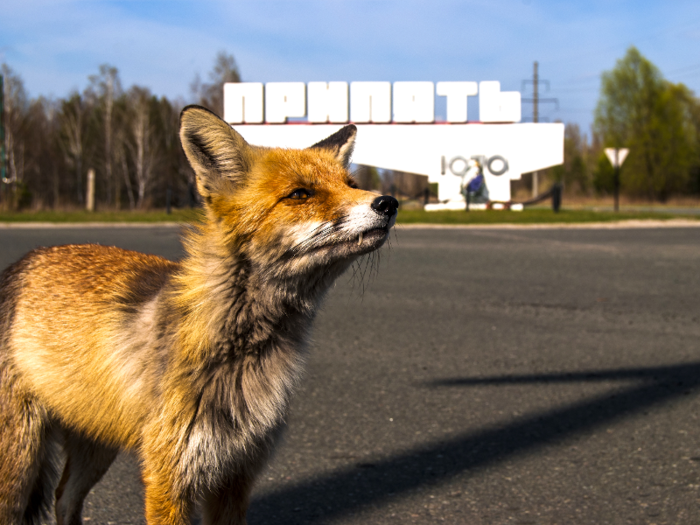
But in recent years, the site has also become a hotspot for tourists looking to get a firsthand glimpse of the exclusion zone and what remains of the abandoned towns there.
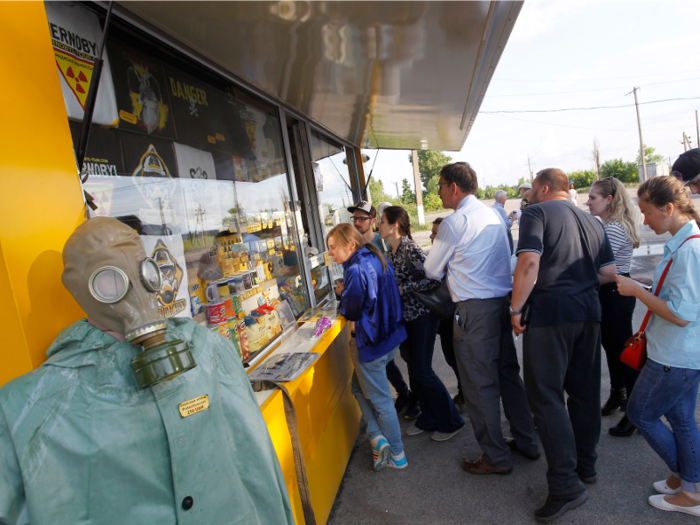
The first wave of tourism started around 2011, which is when the area was opened for the first time to tourists traveling with a licensed guide. The Ukrainian government, however, warned at the time that tourists' safety wasn't guaranteed.
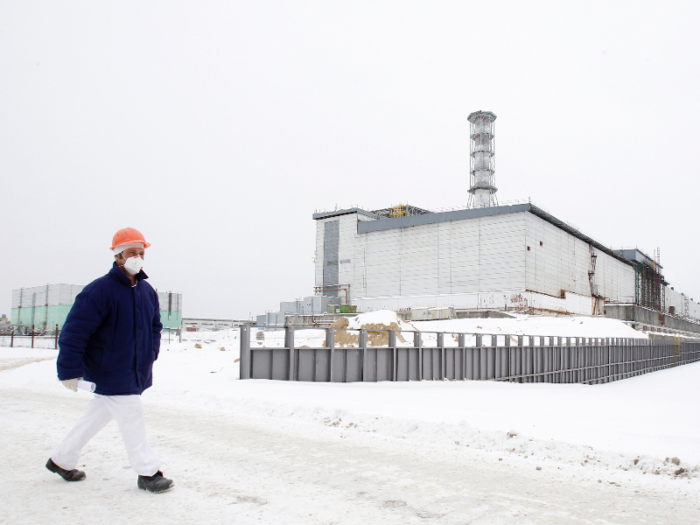
Source: CNN, The Guardian
But in July 2019, Ukraine President Volodymyr Zelensky announced that the site would become an official tourist attraction. He said the area would undergo some changes that would make the area more tourist-friendly, like a "green corridor" that would offer safe entry to the exclusion zone.
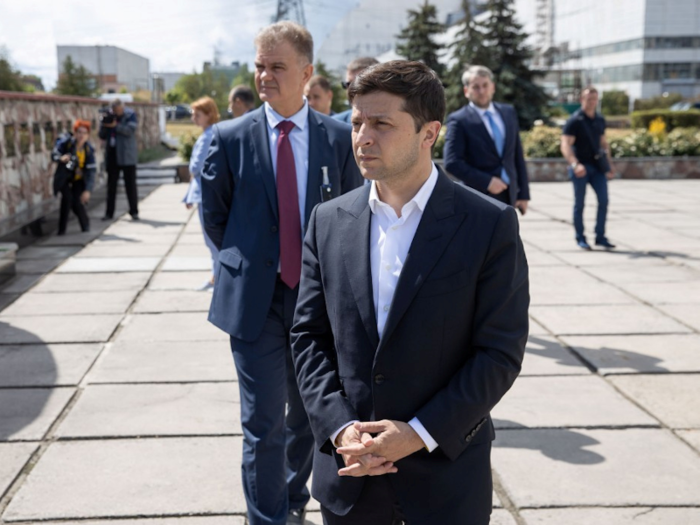
Source: CNN
"Until now, Chernobyl was a negative part of Ukraine's brand," Zelensky said as he signed the decree in July 2019. "It's time to change it."
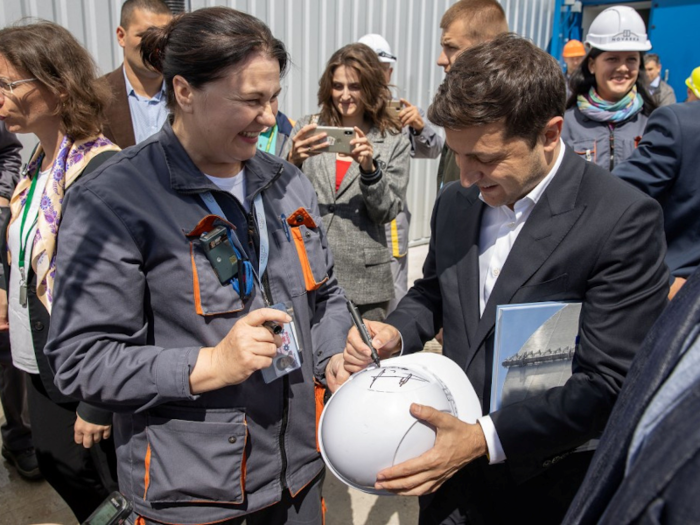
Source: CNN
Visitor interest is something that several local tour groups around Chernobyl are taking advantage of.

The guided tour company SoloEast has been taking visitors into Chernobyl since 2000, according to CNN. And the website for Chernobyl Tour advertises an "eye-opening experience of post-apocalyptic world."
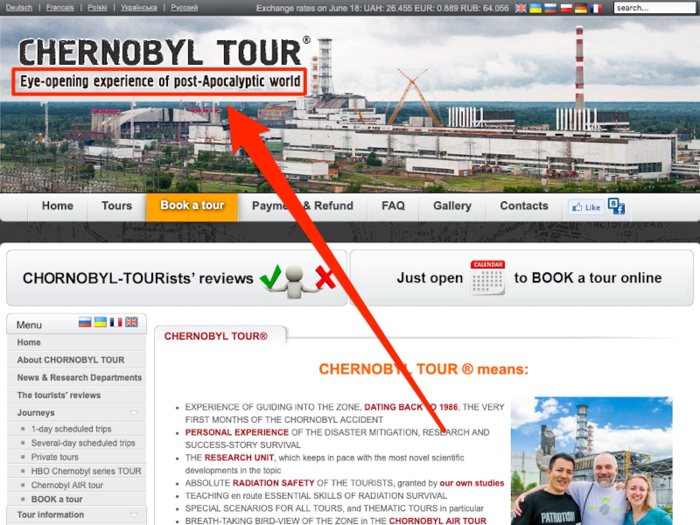
Source: Chernobyl Tour and Chernobyl Welcome and CNN
When Taylor Zwick, a tourist from Prague, booked his May 2019 guided tour of the exclusion zone through Chernobyl Tour, he told Business Insider that he had to provide his passport number.
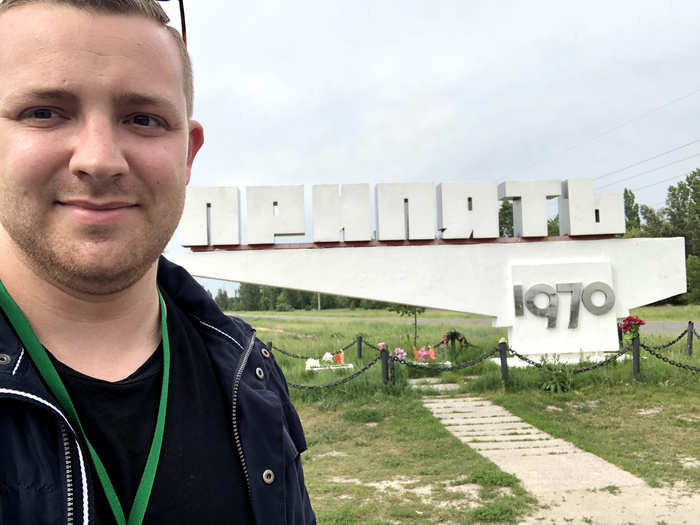
Ines Aguilera, a Spanish student living in Copenhagen, said tour guide officials from Chernobyl Tour were very strict about that before she visited the exclusion zone during a different tour in mid-May. "We had to show our passports many times," she told Business Insider.
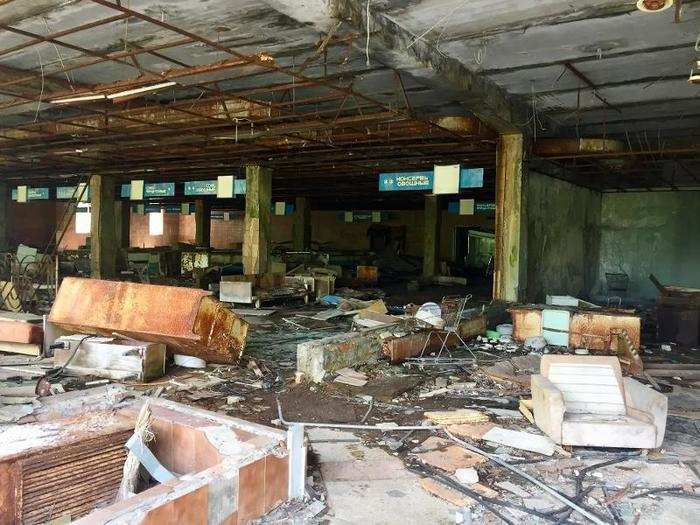
Aguilera and a group of friends were studying abroad in Copenhagen when they decided to go. "It's like one of these weird things that you've always wanted to do as a kid," Aguilera said.
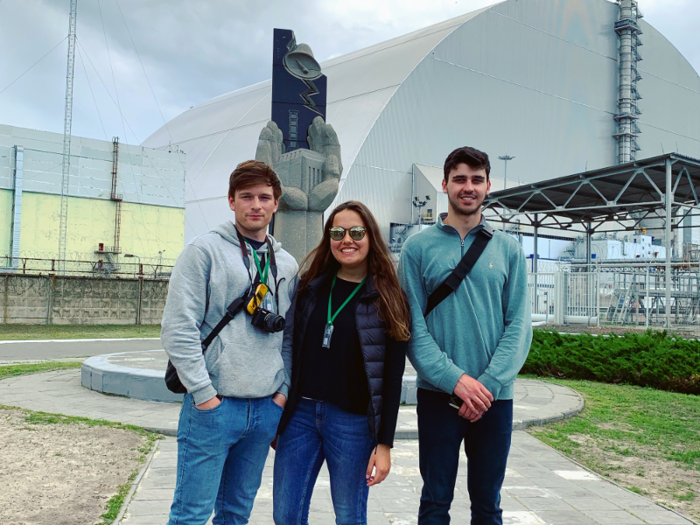
Zwick said it cost about $80 USD for a full-day tour, and Aguilera said her tour cost her about $88 USD. When we checked the Chernobyl Tour website in August, we found one-day trips priced at $99 and up. SoloEast's one-day tours are priced at $91 and up on its website, as of August.
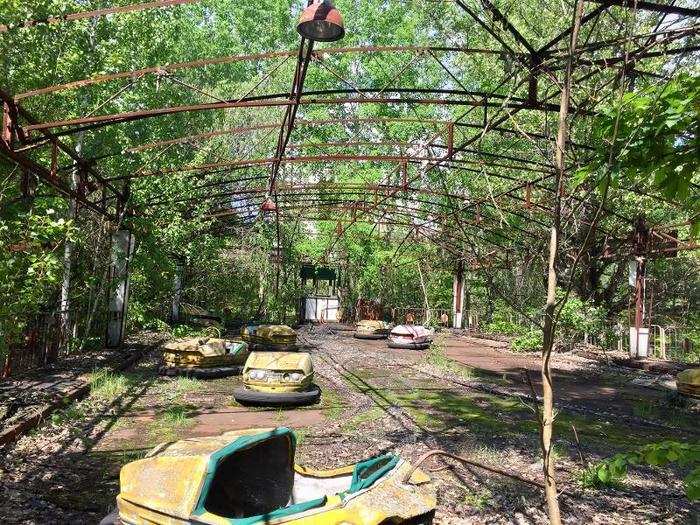
Source: Chernobyl Tour and SoloEast
Zwick said he paid for part of his tour through PayPal when booking, and he had to pay the rest in person with cash. Aguilera told Business Insider that she had to do the same thing when she booked. She paid the second half in cash when she entered the shuttle bus.
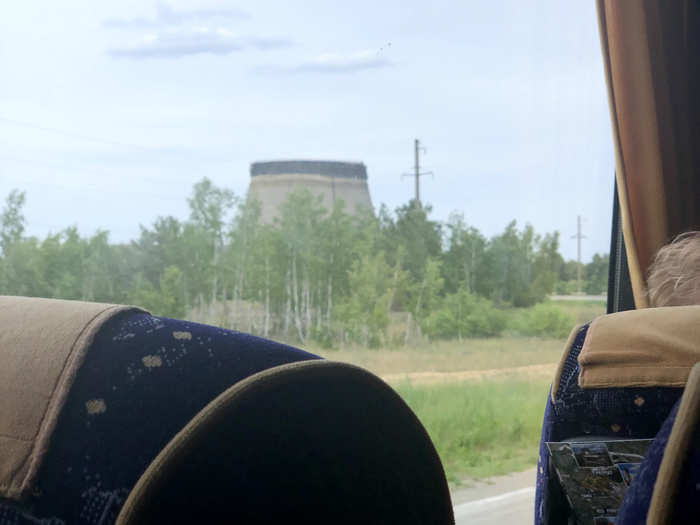
They were given instructions upon booking. Aguilera said they had to wear long sleeves, long pants, and couldn’t have space between their pant legs and socks. They wouldn't be able to touch any metal or the ground while touring Chernobyl either.
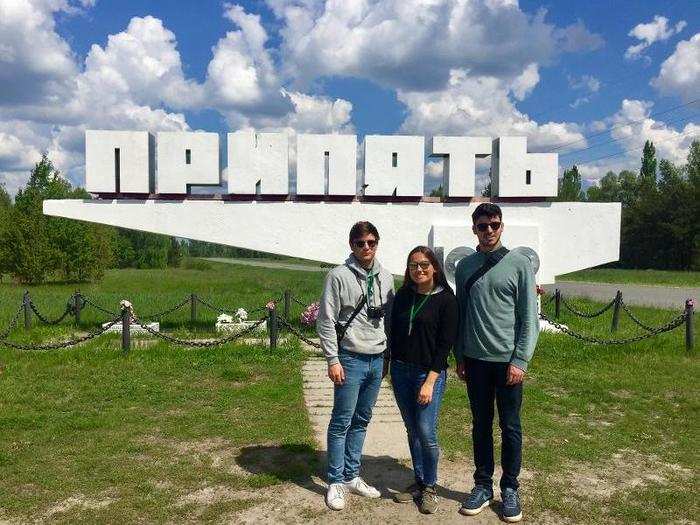
Julia Czub, a student from the UK who toured Chernobyl in May 2019 with SoloEast tour company, told Business Insider that they weren't allowed to touch trees inside the exclusion zone and couldn't leave a bag or anything on the ground.
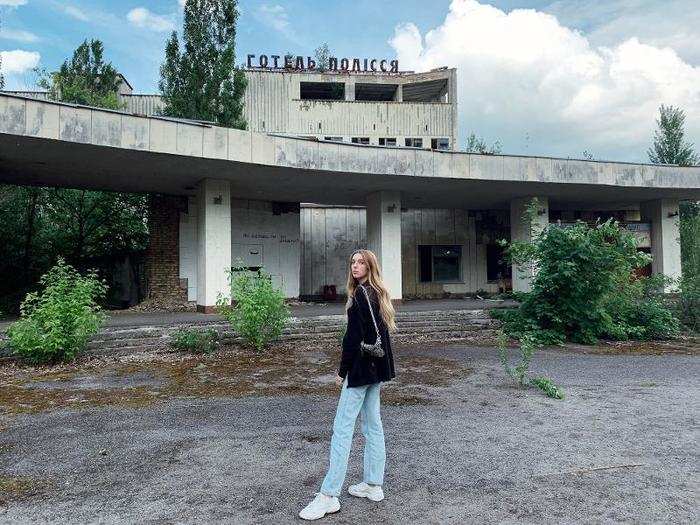
She said she booked the tour in December 2018, nearly six months before the HBO show was released, so interest in visiting Chernobyl certainly predates the successful mini-series.
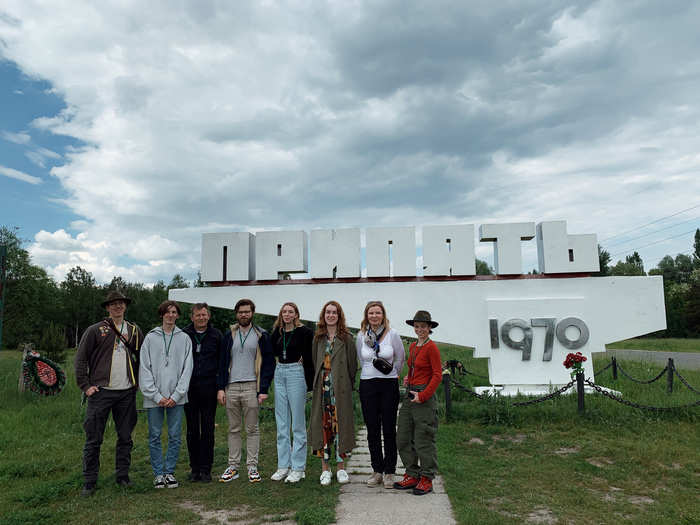
A mix of visitors from nearby European countries were in all three tourists' tour groups. Zwick said he encountered a group from Sweden that had gone to Kiev for a bachelor party and decided to take a private tour of Chernobyl.
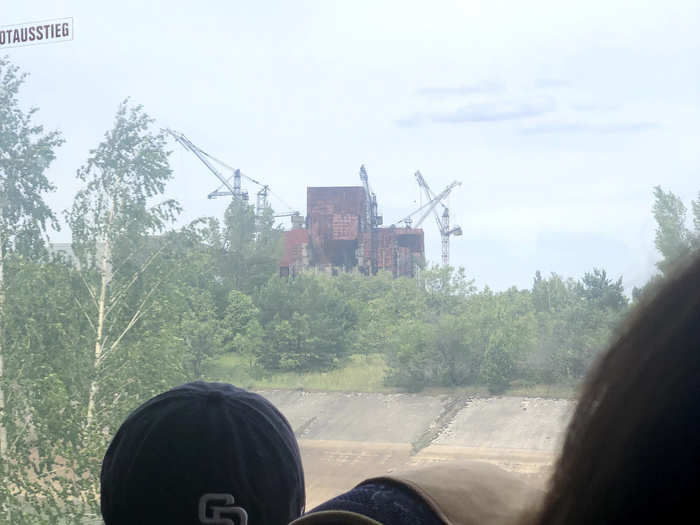
After booking online, visitors received a QR code, which is how they gained entry into Chernobyl, according to Zwick. The code was scanned when boarding the bus in Kyiv that took them to Chernobyl.
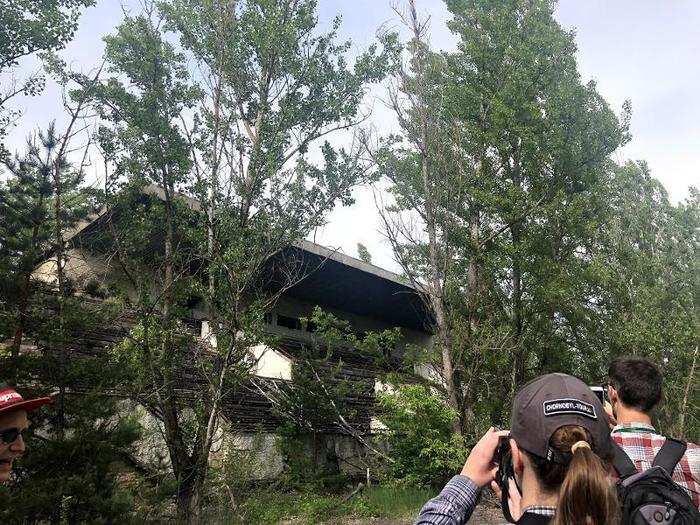
Zwick said he met the bus at Kiev's train station. It was a full-sized coach bus with about 40 to 45 people onboard. The bus left the train station at 8 a.m. ...
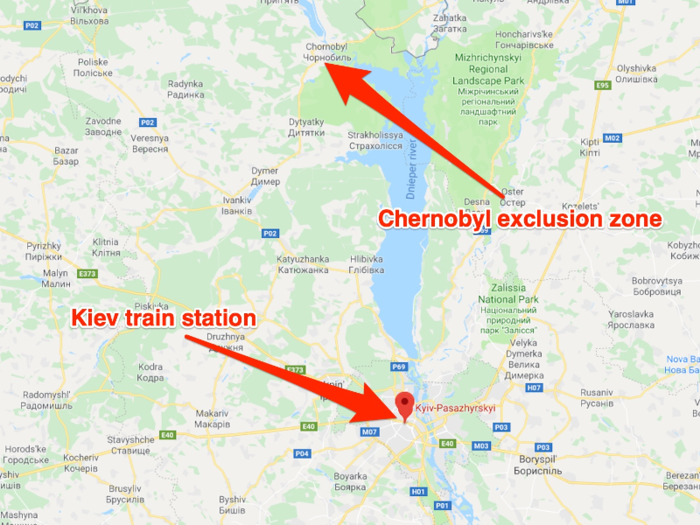
... and Zwick said it took about two hours to get to the Leliv checkpoint at the outer edge of the smaller, 10km (6 mile) exclusion zone surrounding the power plant.
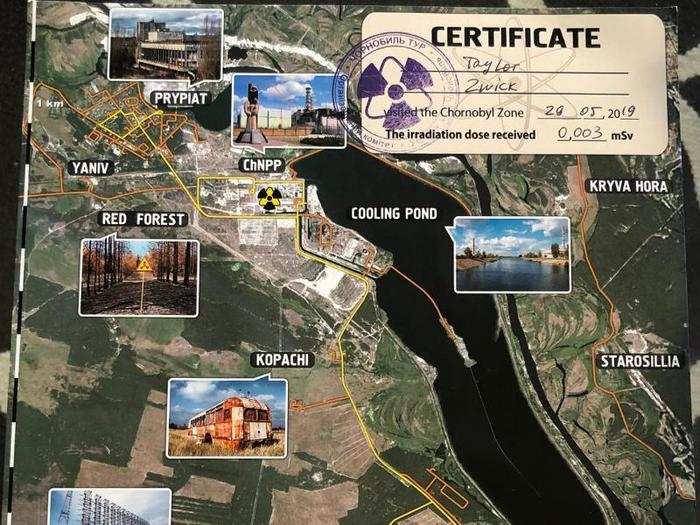
Aguilera said that her drive wasn't the most enjoyable. "It was very uncomfortable because the roads were so bumpy," she said.
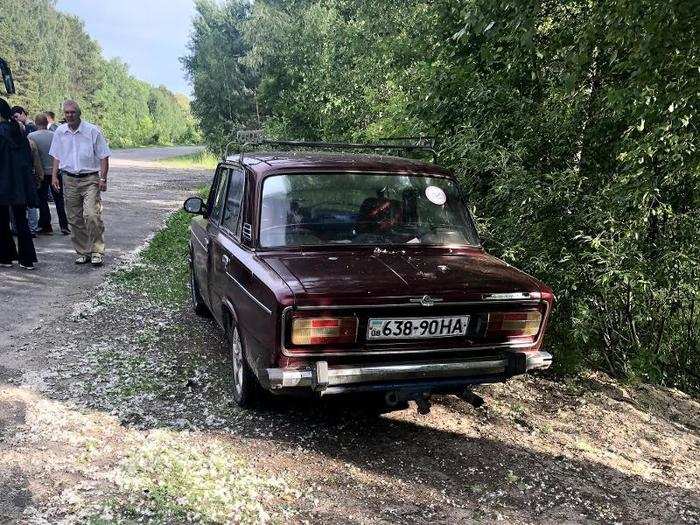
Before entering the exclusion zone, Zwick said they were given what looked similar to flash drives attached to green lanyards that they were to put around their necks.
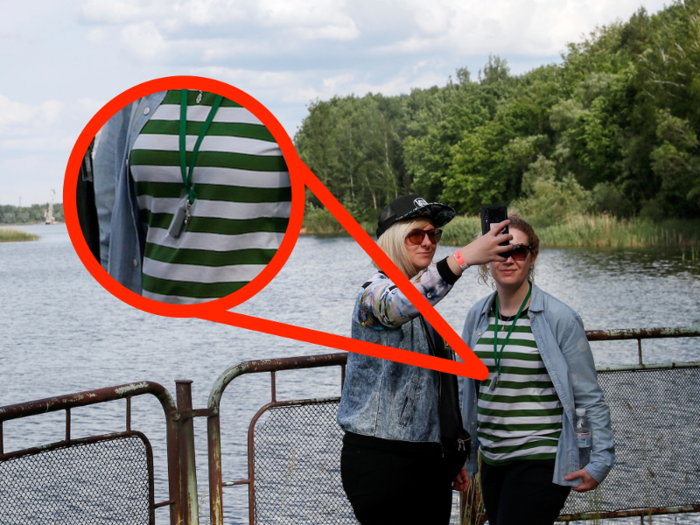
The devices were meant to measure the different radiation levels they were exposed to while on their tour. Zwick said that the tour guides collect them at the end of the tour and give them to officials.
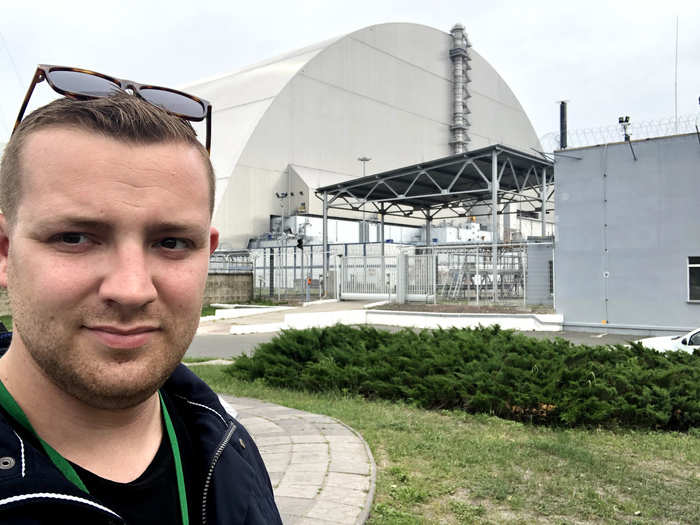
After stopping at the Leliv checkpoint, Zwick said they turned onto a side road toward Moscow's Eye, or the Duga-1 radar station, that Soviets intended to use as a warning system against US missiles in the Cold War era.
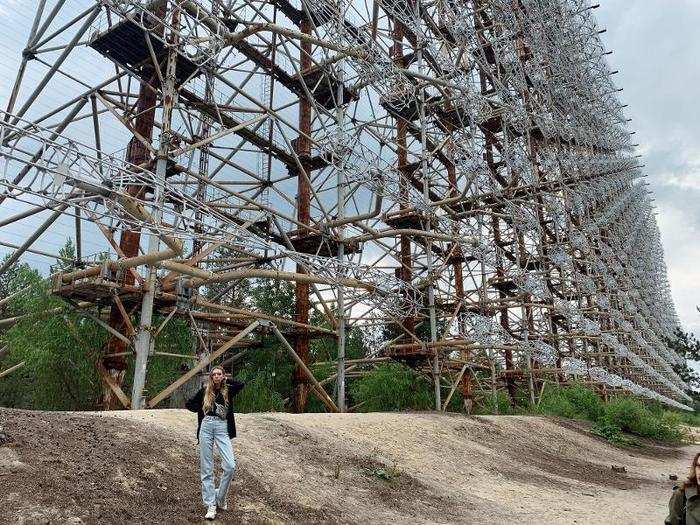
By about 1 p.m., Zwick said they drove the rest of the way to the Chernobyl power plant.
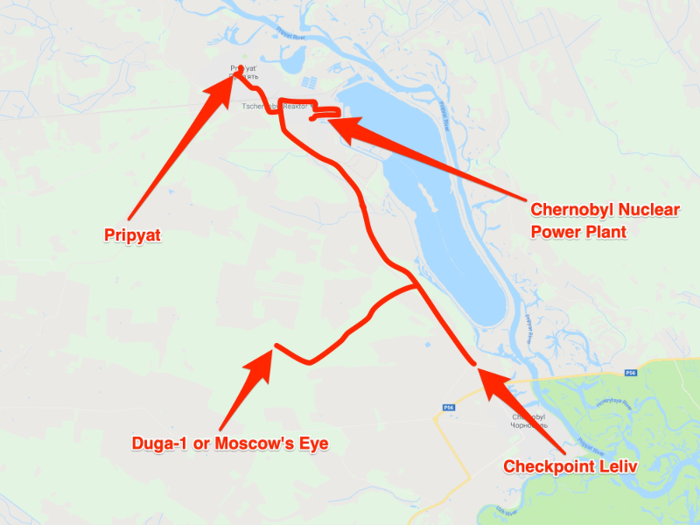
Czub said you're not allowed to take photos too close to the reactor, but she was still able to get near it. "I had no idea that we would be able to get so close to it," Czub said. "We were literally right next to it."
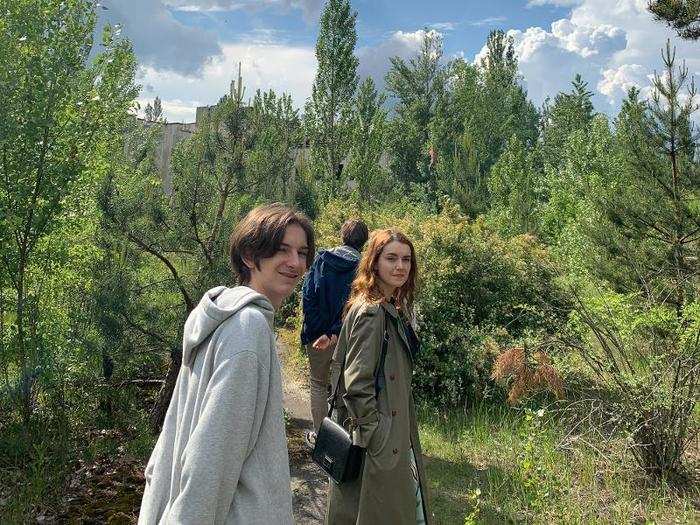
Zwick said he ate lunch at the Chernobyl Canteen where the workers eat, which is right next to the power plant. There's a workforce that lives nearby and works on the plant three weeks at a time before taking a break to avoid extreme exposure to the radiation.
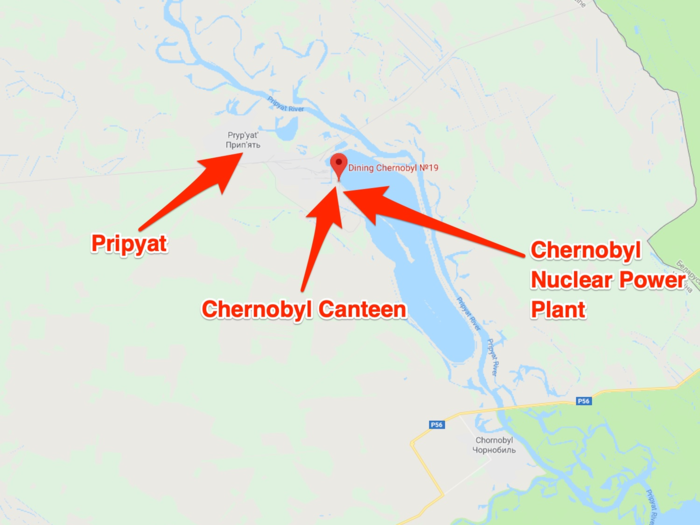
Zwick said he saw dogs hanging out in front of the cafeteria. Czub said that she also saw many of the "Chernobyl dogs" around the zone during the tour.
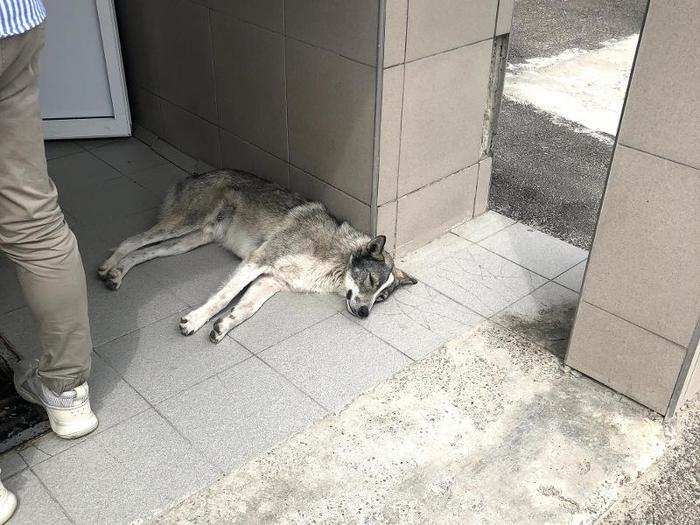
Zwick said the food was included in the tour package he purchased. He was served mashed potatoes, chicken, and soup, and he said it was decent. Aguilera said she brought her own meal after reading so many bad TripAdvisor reviews of them.
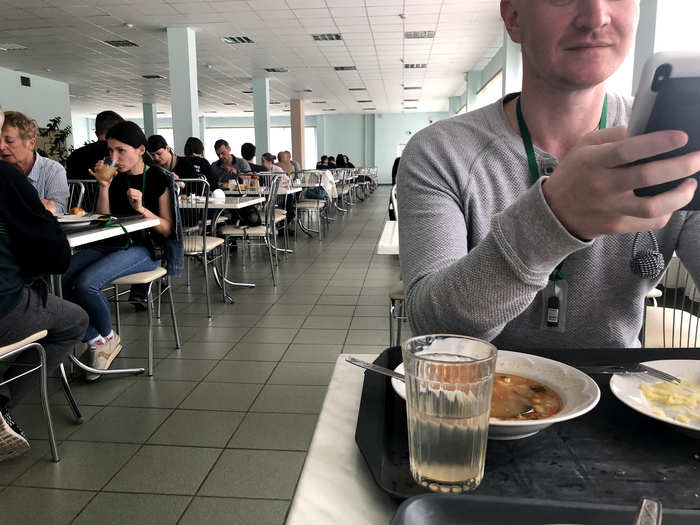
Zwick said they stayed in the cafeteria for 30 minutes to an hour before heading to Pripyat, the abandoned ghost town that was once the shining star of the Soviet Union. The town housed plant workers back in the 1980s.
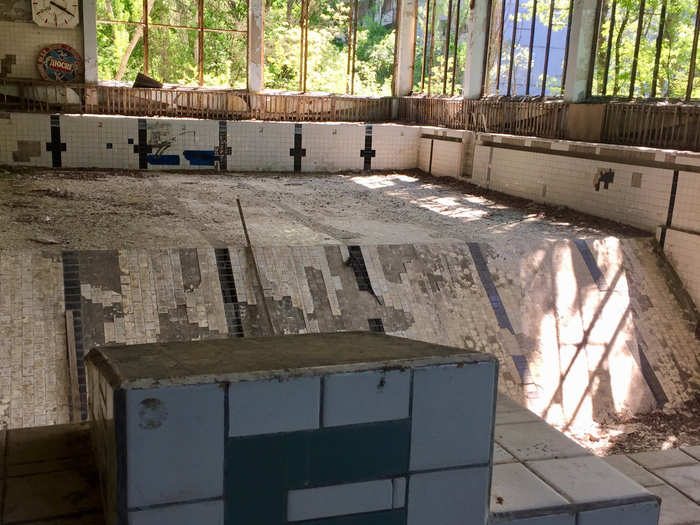
There were swimming pools, supermarkets, and other attractive amenities that have since spiraled into decay.
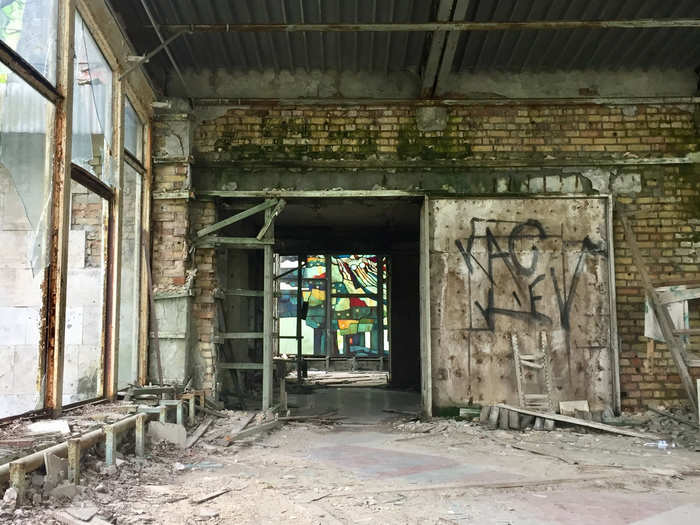
Czub said Pripyat was her favorite part of the tour. "I didn't expect the city to look so interesting," she said.
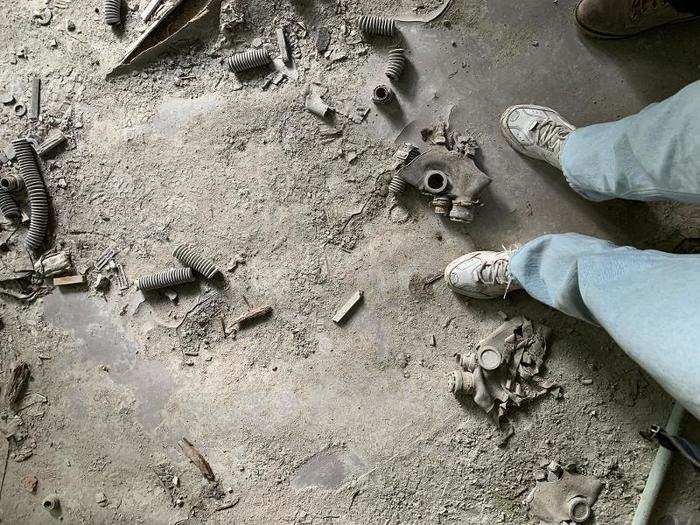
She said there was a cafe right next to the river with beautiful stained glass windows. They wandered around Pripyat for an hour to an hour and a half, Zwick said.
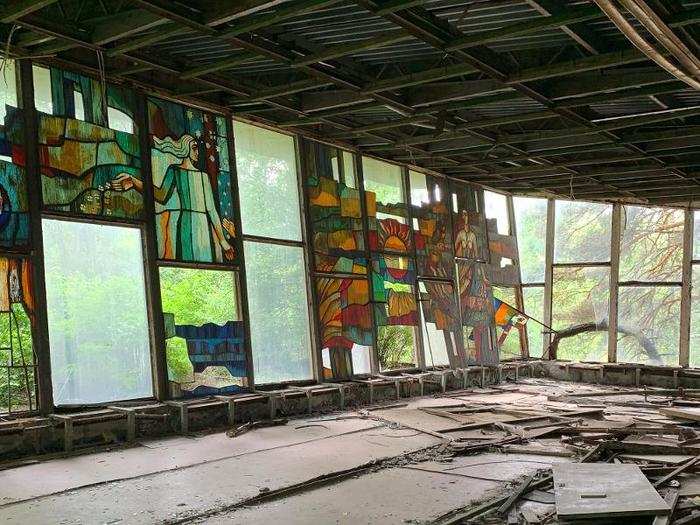
There were some areas that Zwick said their group's tour guide didn't take them. For example, they didn't see the swimming pool like Aguilera was able to.
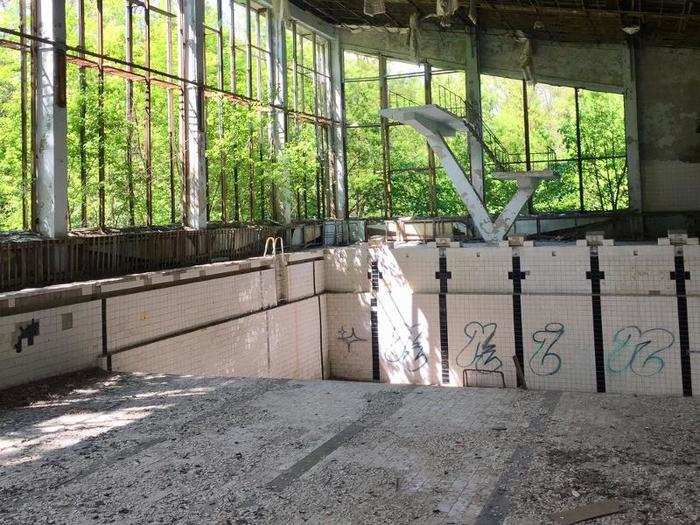
"That was our highlight," Aguilera said of visiting the abandoned pool.
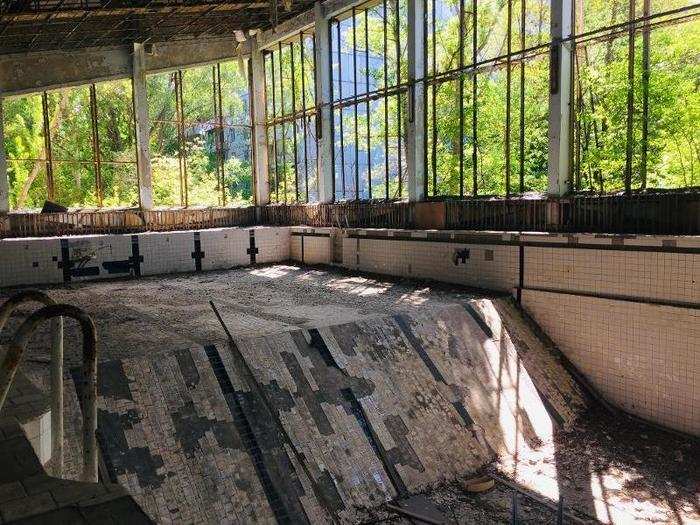
Zwick said the itinerary isn't super strict, it just depends on what everyone in the tour group wants to do.
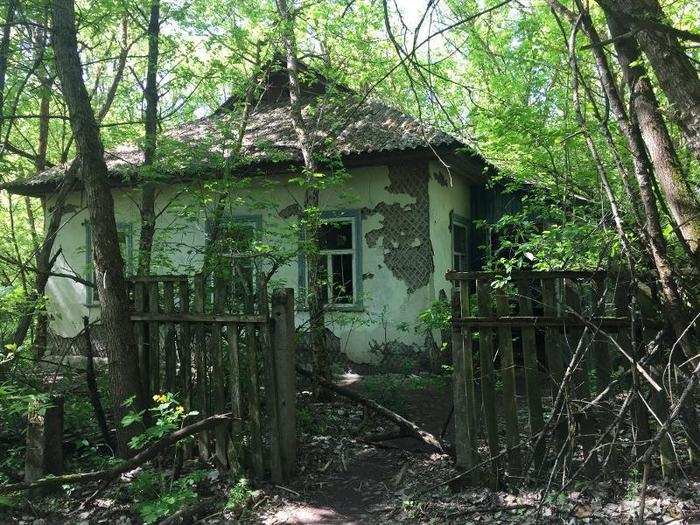
Throughout the trip, Zwick said he carried a Geiger counter, a device that can measure radiation levels, that he rented from the tour company for $10.
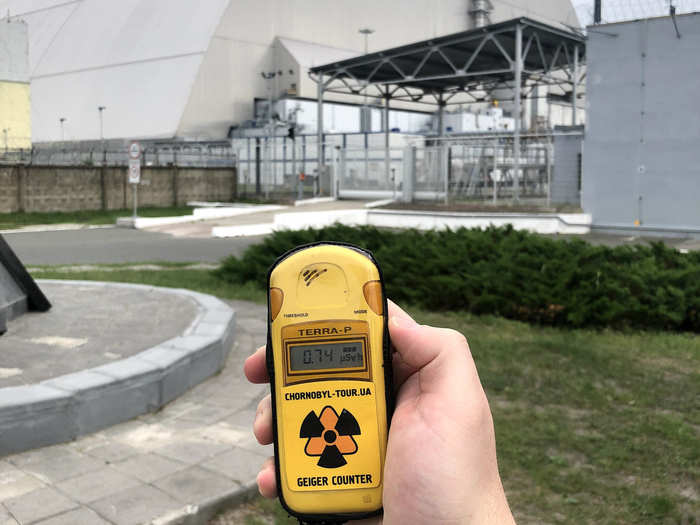
Aguilera said she and her two friends also rented one to use throughout the trip.
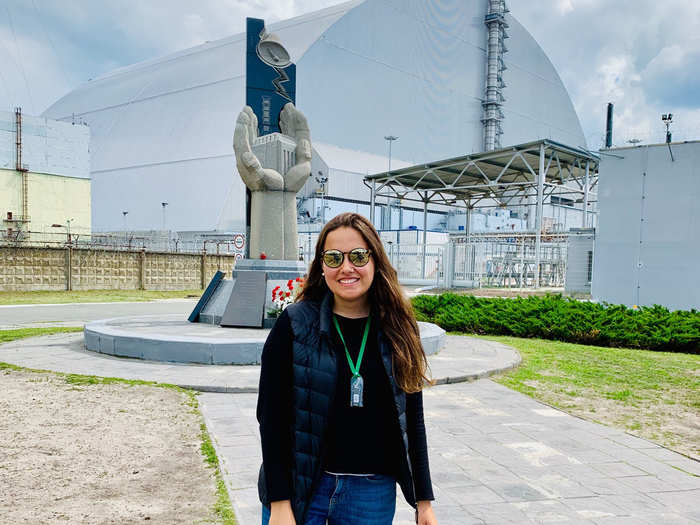
Zwick said his readings fluctuated throughout his tour through the contaminated exclusion zone. In front of the reactor at the nuclear power plant, Zwick said his counter gave off normal readings
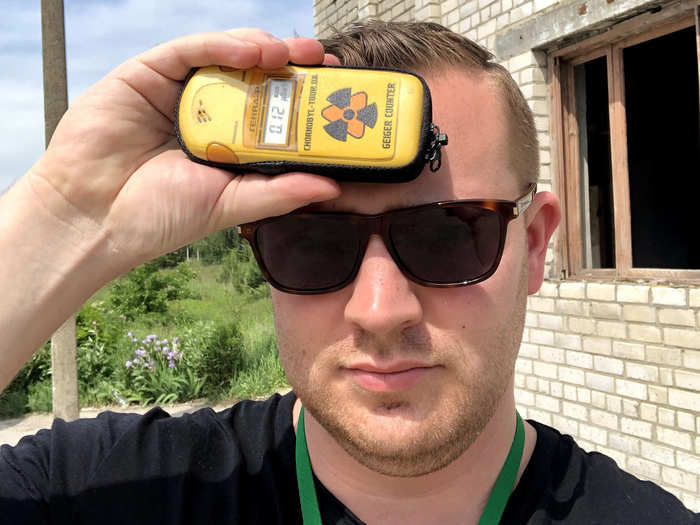
But at one point it reached 200 mSv near the Ferris wheel in Pripyat's amusement park. A normal radiation reading is 3 mSv.
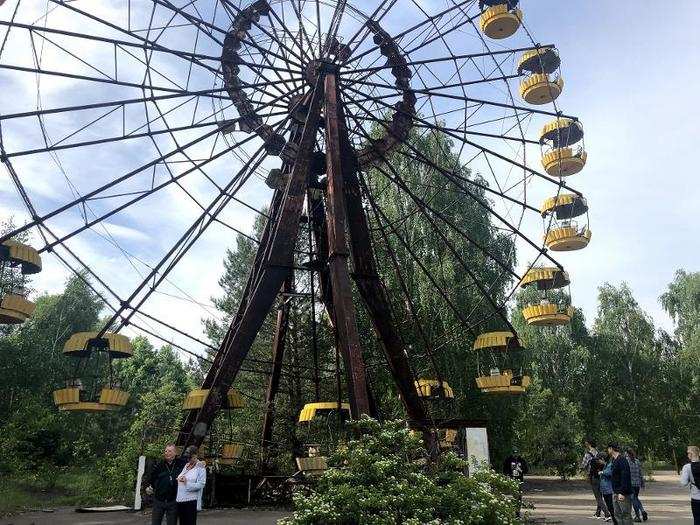
Zwick said a tour guide told them that the reading near the Ferris wheel was because of a speck of radioactive dust that had traveled from the reactor to one of the Ferris wheel cars at the time of the explosion, and it's still there giving off a high radiation level.
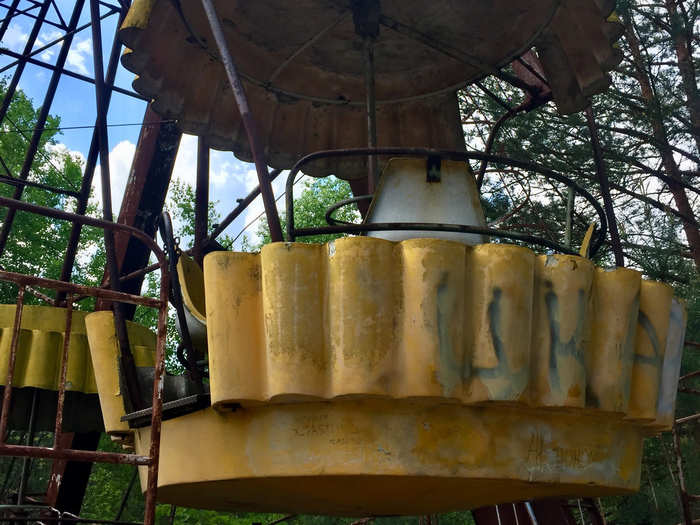
Many of the buildings in the zone are made of concrete. Zwick said tour officials told him that most of the wooden buildings had to be demolished since wood traps radiation.
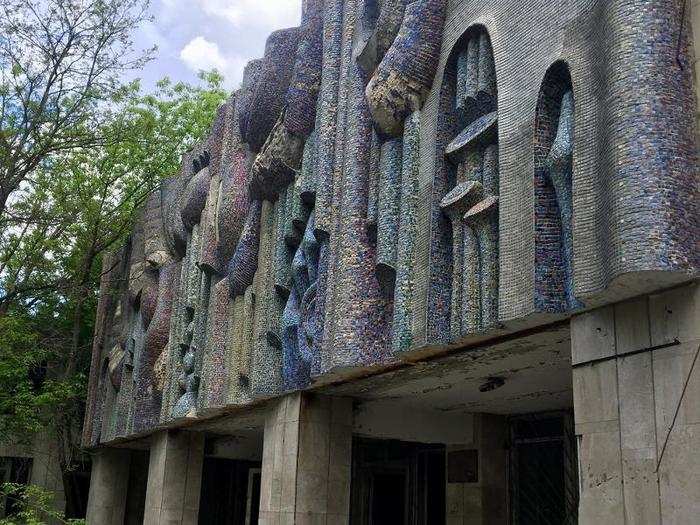
But Aguilera said even the remaining concrete structures are deteriorating.
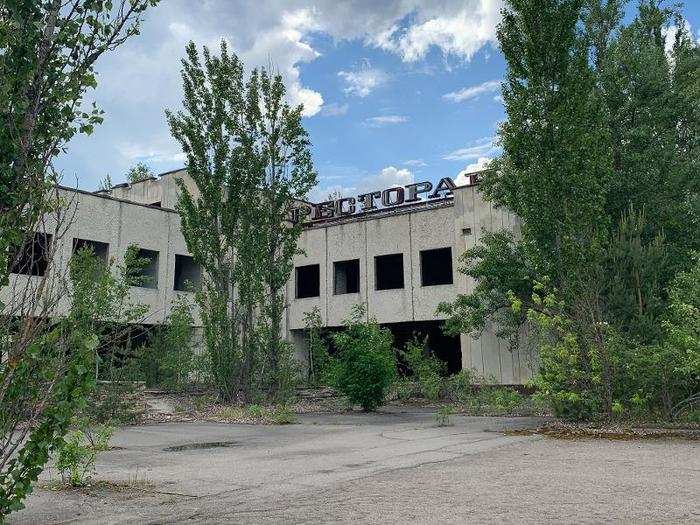
"I don’t know how long these tours are going to be possible because the buildings are about to collapse," Aguilera said.
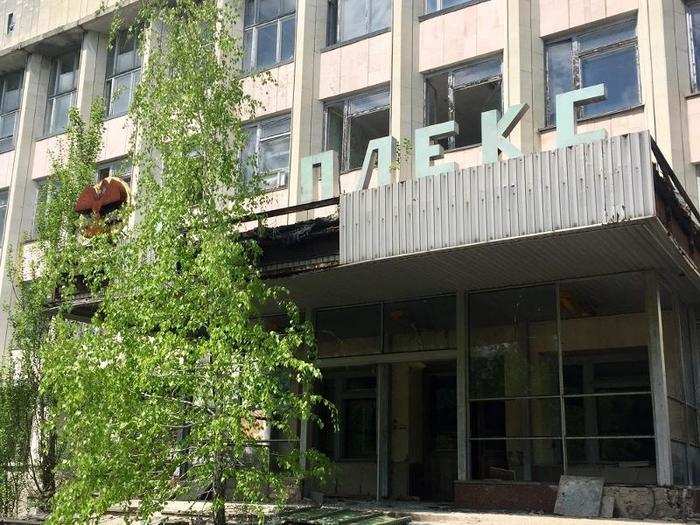
Many of the signs on top of buildings are in the Ukrainian language, but the signs inside an abandoned store were in Russian, Zwick said. He said that he was told that at the time, Russians were trying to usher out the Ukranian language, so they tried to include a lot of Russian when they originally built the city of Pripyat.
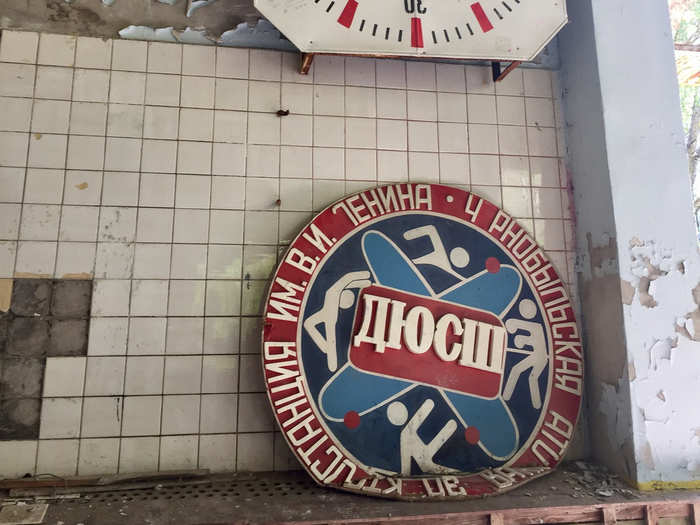
Pripyat was the last stop on the tour, Zwick said. After that, they started to head back to Kiev. At the checkpoint, they had to get out and go through radiation scanners.
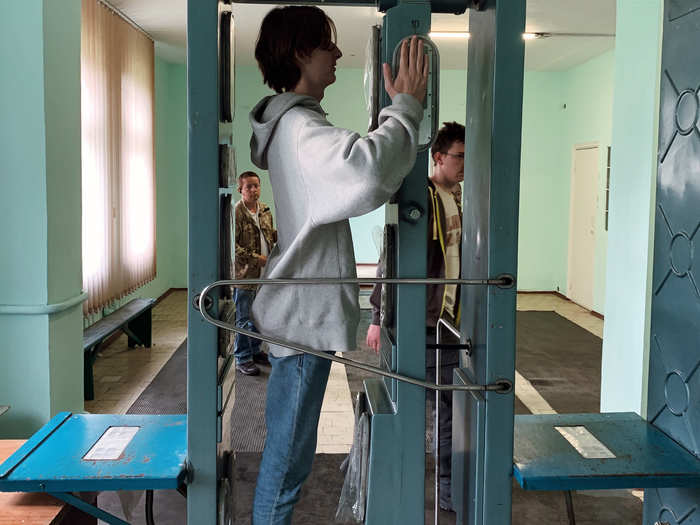
Zwick said it was similar to walking through a metal detector. He said the point of it was to make sure each visitor didn't absorb an abnormal amount of radiation. "It was just like going through a door," Aguilera said.
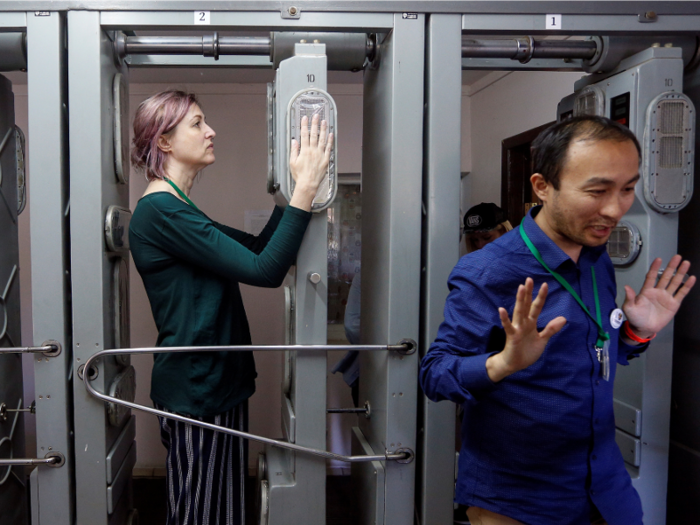
He also said there wasn't even someone standing next to the scanner. "It looks like a very secure place, but at the end of the day, they were just sitting there," Zwick said.
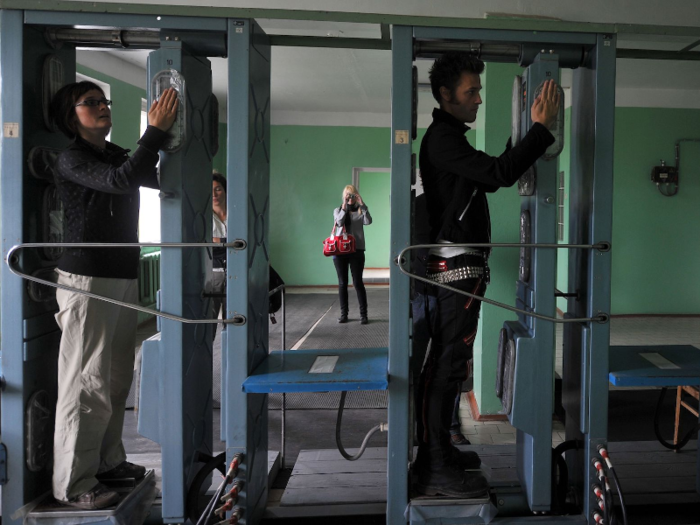
Zwick said he felt like the radiation scanners were more of a formality.
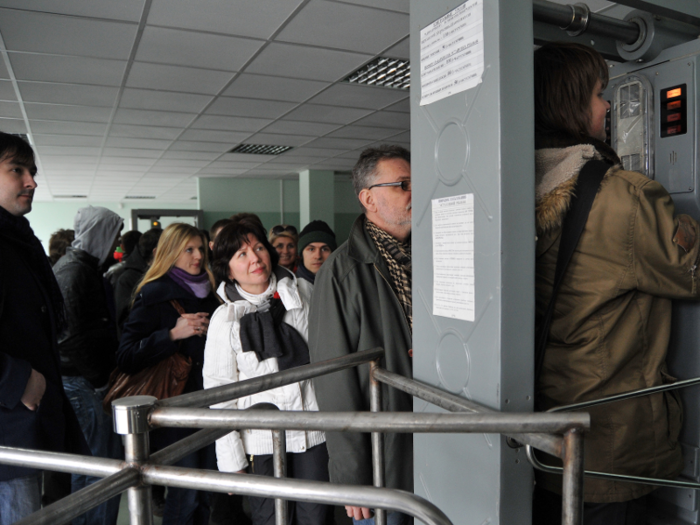
Zwick said that at the various checkpoints, there were souvenir shops where you could buy sweatshirts, hats, snacks, and Geiger counters.
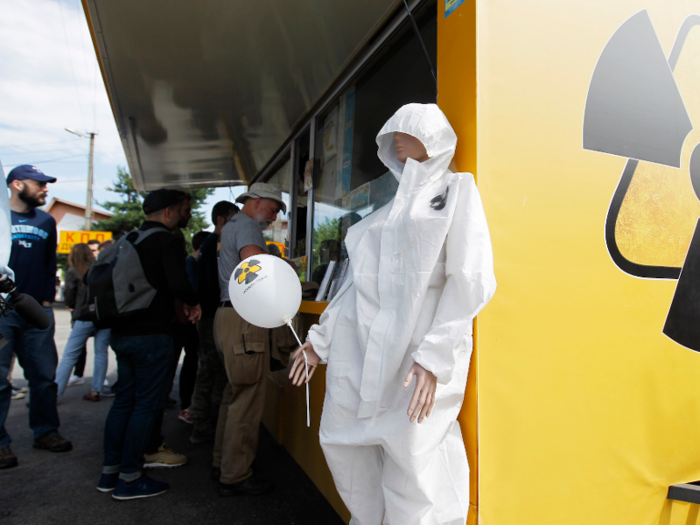
Czub also said she saw the souvenir stall, though she said it felt weird to her to purchase something. But "there were a lot of people buying things," she said.
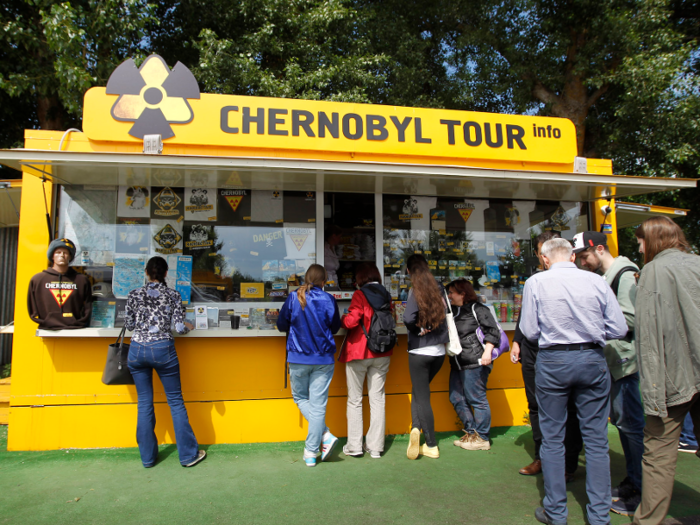
Aguilera said she bought some postcards and a patch to put on her backpack.
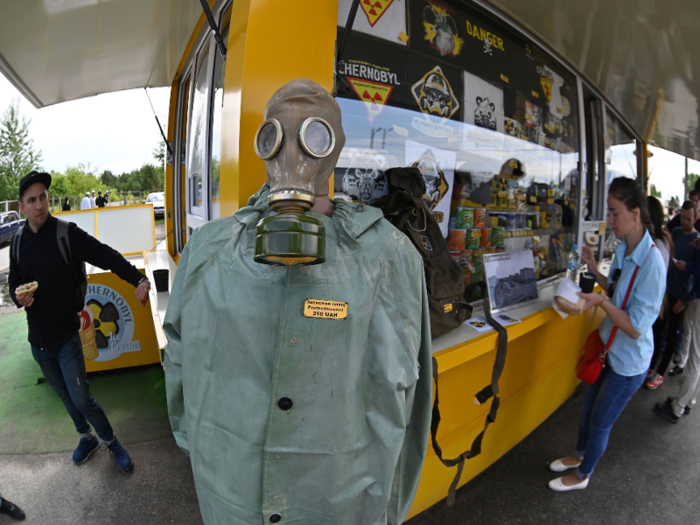
Zwick said he was inside the Chernobyl exclusion zone for a total of almost nine hours. Aguilera said the same.
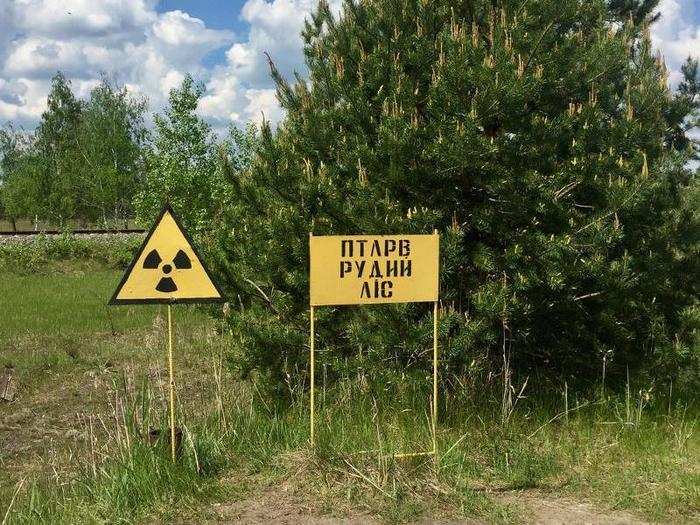
All three visitors that we spoke to also said tour guide officials told them that the radiation they were exposed to was minimal.

"We had more radiation going from Copenhagen to Kiev than in the exclusion zone," Aguilera said. "At least that's what they told us."
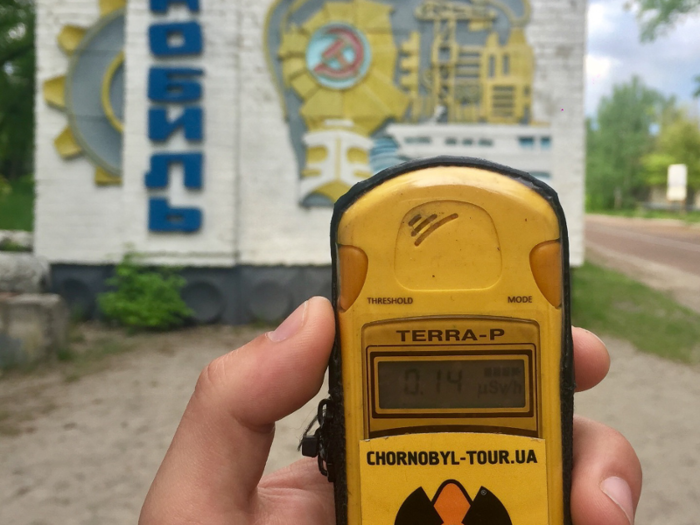
Zwick said he was also told that the radiation he was exposed to from spending the whole day there was the equivalent of a 3-hour flight and that a chest X-ray gives you 40 times more radiation than did the tour they were on.
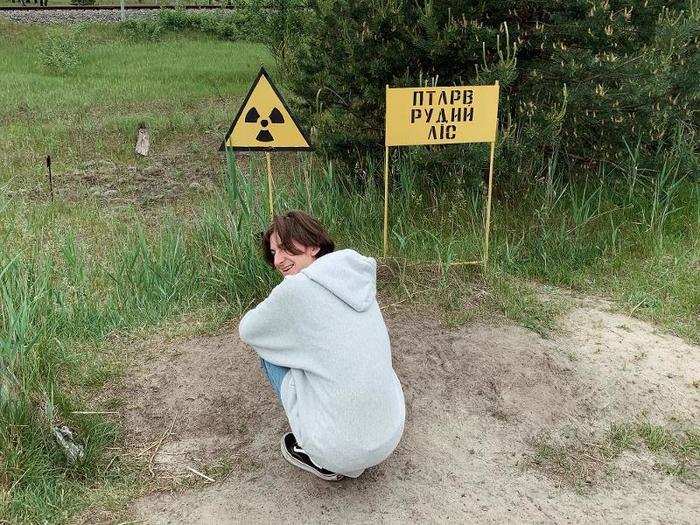
As more and more tourists travel to the Chernobyl Exclusion Zone, some have viewed the visitors as insensitive to the gravity of the tragedy that left dozens dead and hundreds of thousands more without homes.
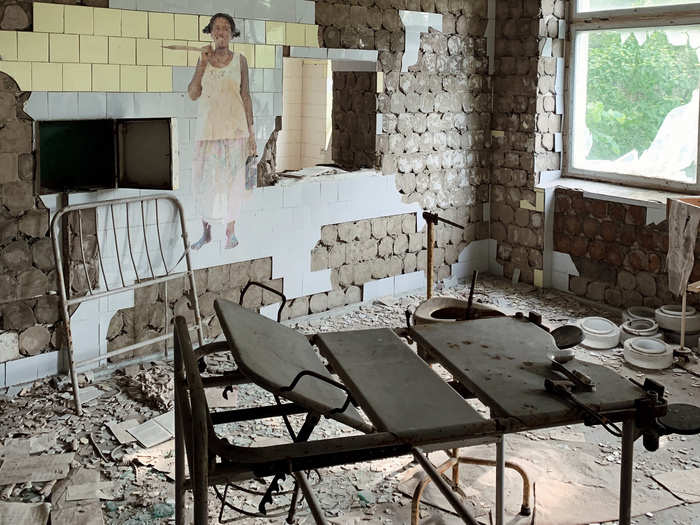
Source: CNN
For years, some have referred to Chernobyl tourism as "dark tourism," a trend of visitors flocking to sites marked by death and suffering.
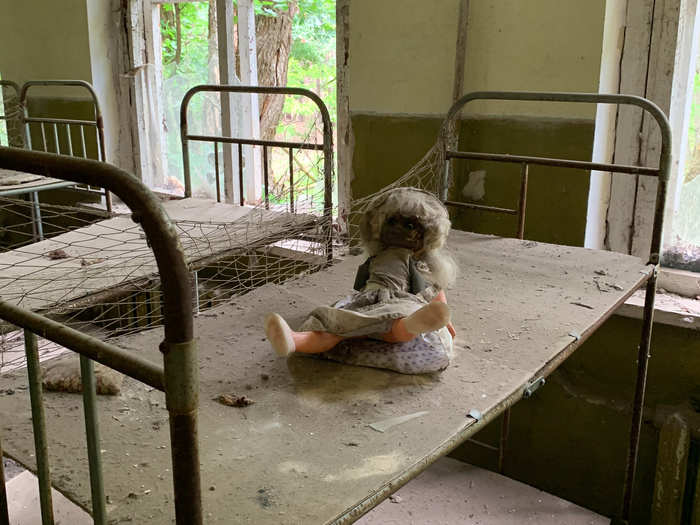
Source: CNN
Photographer David McMillan has visited and photographed the Chernobyl exclusion zone at least 20 times over the course of 25 years. He told Business Insider that he's watched as tourism has grown increasingly common at the site.
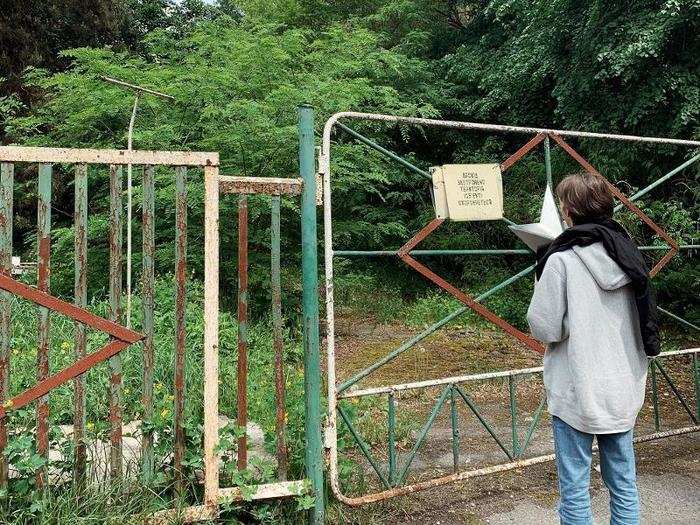
"They're there with their smartphones taking selfies," McMillan said.
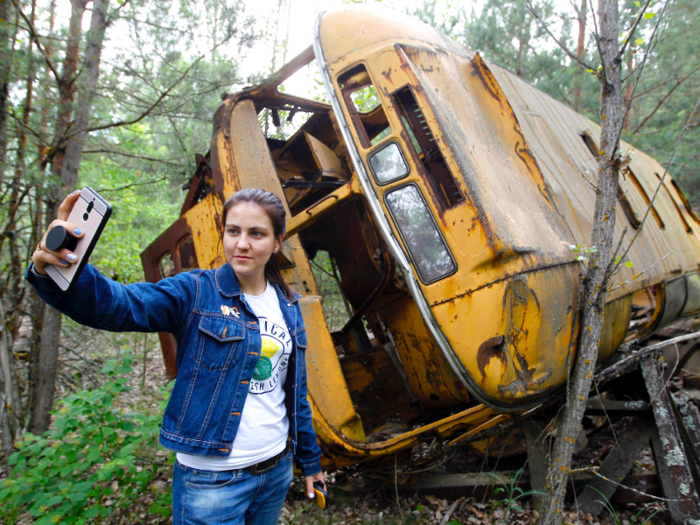
But Czub said that, though she took photos throughout her tour, she tried to be mindful and respectful. A native of Poland, she said people from her country are specifically interested in Chernobyl because they're so close to the site of the disaster.
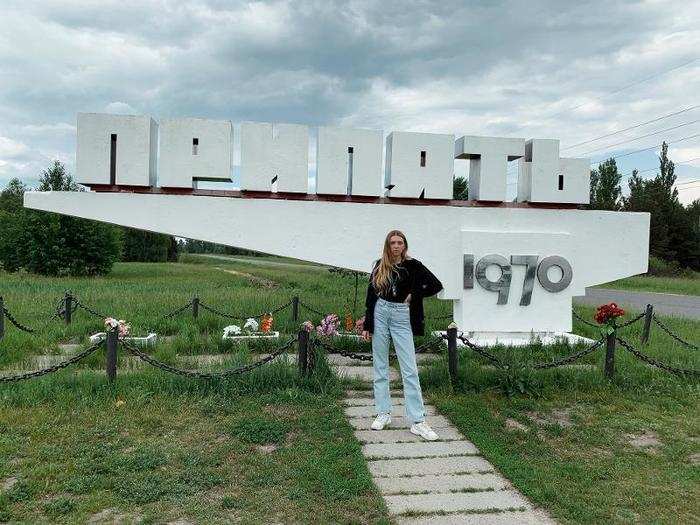
Zwick said his trip to Chernobyl taught him more about the history of the disaster and what happened in the aftermath.
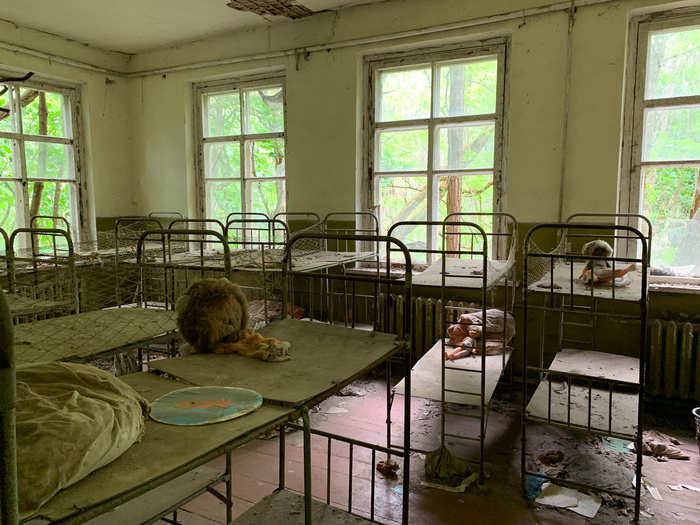
And Aguilera said she tried to stay respectful throughout the tour and that she's always been moved by the story of the Chernobyl accident.
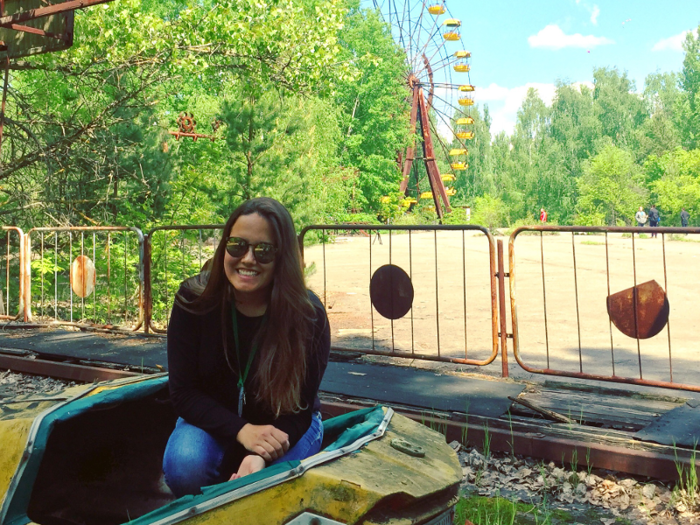
She also said she's seen the HBO mini-series since taking her trip through the Chernobyl Exclusion Zone and that the show's recreation of the scenes inside the zone are realistic.
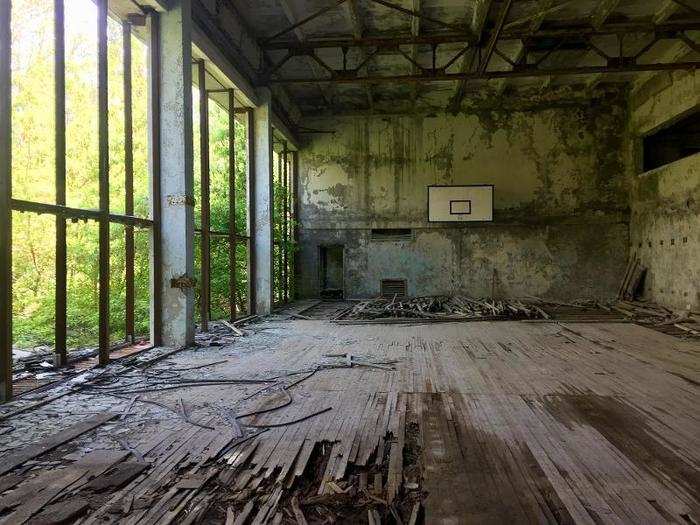
"I see my photos and then I see the TV show — it looks quite similar," Aguilera said.
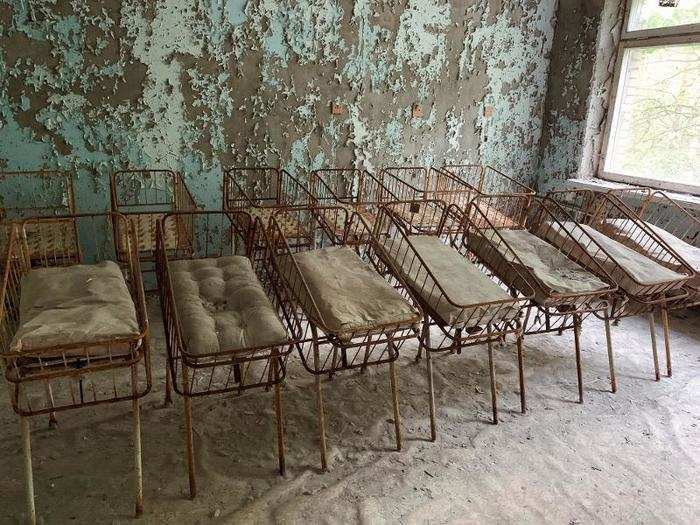
Czub said the HBO show will likely keep drawing crowds, and so does the owner of the SoloEast tour group, who told CNN that he's seen an almost 40% increase in interest since the mini-series aired.
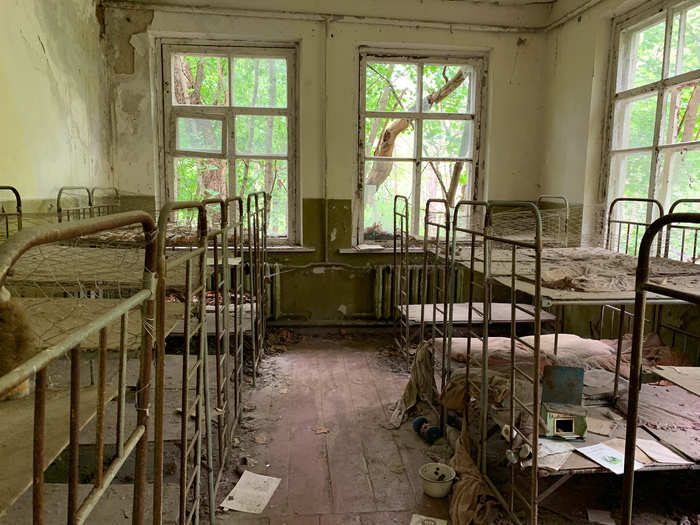
Source: CNN
"I'm guessing there's going to be more and more coming now," Czub said.
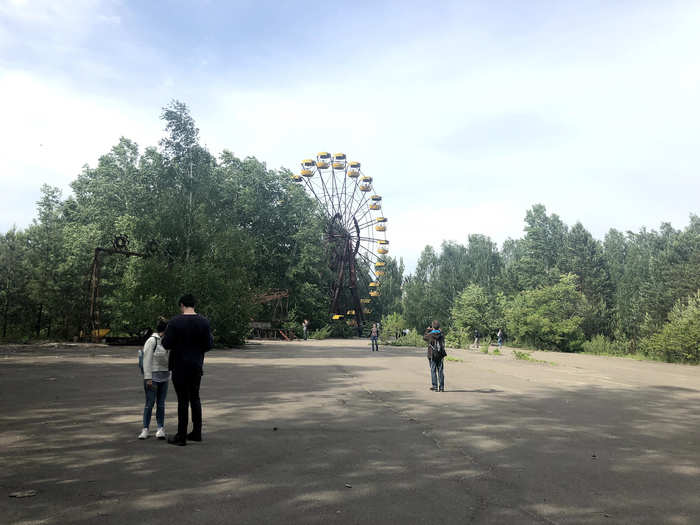
Popular Right Now
Popular Keywords
Advertisement